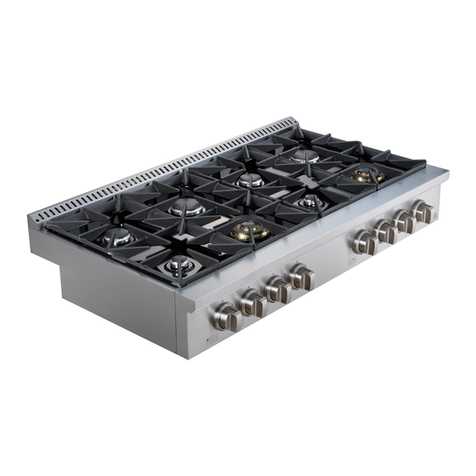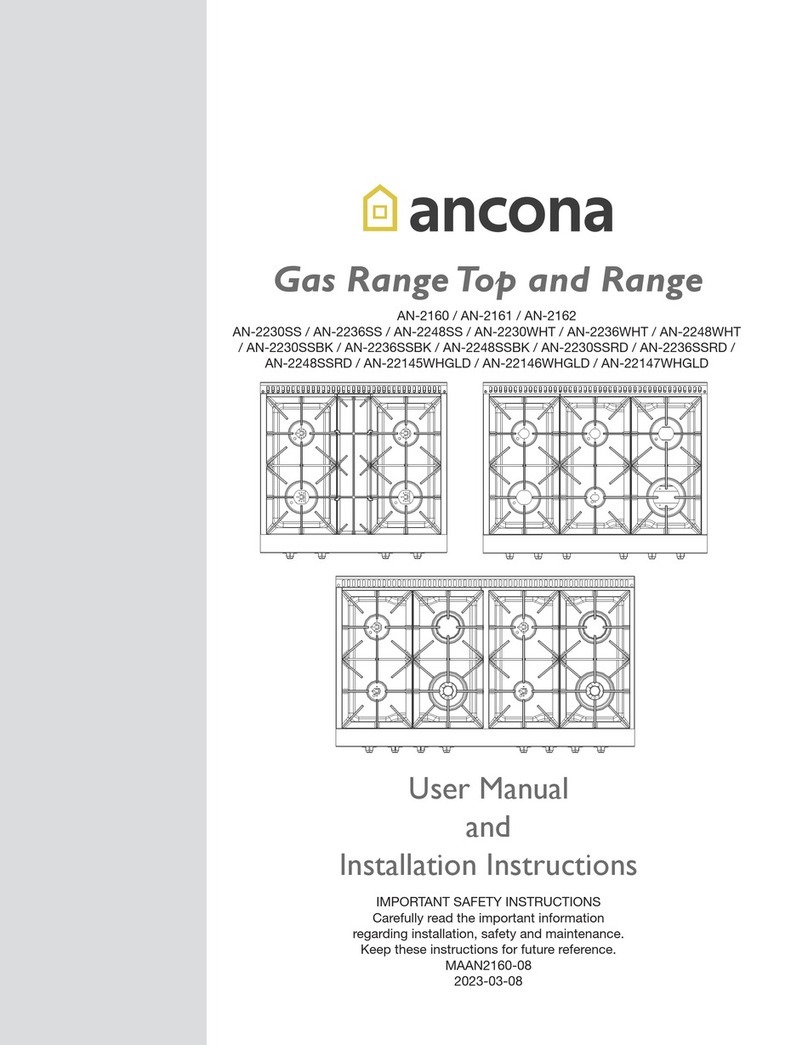
— 10 —
Important Safety Information
GAS CONNECTIONS
Important: Do not apply pressure directly to the appliance
manifold pipe when tightening supply connections. The
manifold pipe should be held securely at the pressure
regulator to prevent twisting. Hold the pressure regulator
with a wrench during the tightening of the connection, or
the manifold pipe may be twisted and split and cause a
dangerous leak.
Note: Check all piping connections in the unit for leaks.
Never use an open ame to check for gas leaks. Use some
soap water (50% water and 50% soap) or a leak detector at
all joints and connections to check for leaks in the system.
Do not use a ame to check for gas leaks. It is possible for
connections made at the factory to leak, due to vibration
encountered in transportation. Make certain you have
checked them all, and repair any connections that leak.
• Theapplianceanditsindividualshut-offvalvemustbe
disconnected from the gas supply piping system during
any pressure testing of that system at test pressures in
excess of 1/2 psig.
• Theappliancemustbeisolatedfromthegassupplypiping
system by closing its individual manual shut-off valve
during any pressure testing of the gas supply piping system
at test pressures equal to or less than 1/2 psig (3.5kPa).
GAS LINE SHUT-OFF VALVE
• Toreducethepossibilityofgasleaks,applyTeontape
or a thread compound approved for use with LP or
Natural gases to all threaded connections.
• Installamanualgaslineshut-offvalveinthegasline
in an easily accessed location outside the range in the
gas piping external to the appliance for the purpose of
turning on or shutting off gas to the appliance.
• Installmale1/2’’areunionadapterto1/2”NPTinternal
thread elbow at inlet of regulator. On models equipped
with standard twin burners, install the male pipe thread
end of the ½” are union adapter to the ½” NPT internal
thread at inlet of pressure regulator. Use a wrench on the
regulator tting to avoid damage.
• Install male 1/2” or 3/4” are union adapter to the NPT
internal thread of the manual shut-off valve, taking care
to secure the shut-off valve to keep it from turning.
ELECTRICAL DANGER
Electrical Shock Hazard.
Do not use an extension cord.
Failure to follow these instructions can result in death,
re, or electrical shock.
• Anyadditions,changesorconversionsrequiredinorder
for this appliance to satisfactorily meet the application
needs must be made by a qualied service technician
inaccordancewiththemanufacturer’sinstructions
and all codes and requirements of the authority having
jurisdiction. Failure to follow the instructions could
result in serious injury or property damage. The qualied
agency performing this work assumes responsibility for
the conversion.
• DONOToperatethisapplianceusinga2-prongadapter
or an extension cord. If a 2-prong wall receptacle is the
only available outlet, it is the personal responsibility
of the consumer to have it replaced with a properly
grounded 3-prong wall receptacle installed by a
qualied electrician.
• Severeshock,ordamagetotherangemayoccurifthe
appliance is not installed by a qualied installer or electrician.
• Thisapplianceis240V/60Hz(AN-2330SS/(AN-2336SS),
240V (AN-2348SS). It is recommended to connect to a 15-
Amp or 20-Amp power supply.
• TotalInputPoweris3.2kW(AN-2330SS),3.4kW
(AN-2336SS), 5.2 kW (AN-2348SS), 50 A for ranges. A
dedicated circuit, protected by a minimum 15 to 20-amp
time delay fuse or circuit breaker is required.
• Forpersonalsafety,theappliancemustbeproperly
grounded.
• The power supply must be the correct polarity. Reverse
polarity will result in continuous sparking of the
electrodes, even after ame ignition. If there is any doubt
as to whether the power supply has the correct polarity
or grounded, have it checked by a qualied electrician.
• Your range must be electrically grounded in accordance
with local codes or, in the absence of local codes, in
accordance with the National Electrical Code (ANSI/
NFPA 70, latest edition). In Canada, electrical grounding
must be in accordance with the current CSA C22.1
Canadian Electrical Code Part 1 and/or local codes. A
copy of this standard may be obtained from: National
FireProtectionAssociation,1BatterymarchPark,Quincy,
Massachusetts 02269-9101.
WARNINGS:
•Electrical Grounding Instructions: this indoor gas cooking appliance is equipped with a three-prong (grounding) plug
for your protection against shock hazard and should be plugged directly into a properly grounded three-pronged
receptacle.
• Donotcutorremovethegroundingprongfromtheplug.
• Caution: label all wires prior to disconnection when servicing controls. Wiring errors can cause improper and
dangerous operation. Verify proper operation after servicing.































